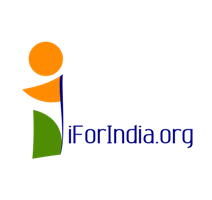iForIndia
iForIndia.org Foundation is a not-for-profit organization which aims to politically empower citizens through the use of technology. It is a platform where citizens can rate the performance of their elected representatives on I for India's web-platform, based on the quality of public services in their assembly constituency. This data is used to generate real-time report cards for Members of Legislative Assembly (MLAs), Members of Parliament (MPs), Chief Ministers (CMs) and the Prime Minister.[1][2]
 | |
| Formation | 2013 |
|---|---|
| Type | Social organization |
| Headquarters | India |
Region served | India |
Founder | Ankur Garg |
Co-Founder | Tarun Jain |
| Website | iforindia.org |
Mission
The goal of this organization is to include more citizens in the democratic process, to inform the voters about their representatives and the quality of public services in their areas. Additionally the foundation aims at bringing data-driven discussions and accountability into politics by tracking the performance of politicians on a real-time basis.[3]
People behind the initiative
iForIndia was founded by Ankur Garg,[2] an IIM Ahmedabad alum[4] and an ex-Microsoft employee[5] and Tarun Jain,[2] a University of Southern California grad and an ex-Capital One Financial employee.iForIndia was founded in 2013.
Report Card
The Report Cards display the aggregated ranking on each of the 24 parameters that users rate their representative's performance on.[6] Each Report Card also contains an overall ranking for the elected official.[7] They also include basic information about the elected public officials like his/her educational background, profession, and participation in Parliament. The report cards are available on the website iForIndia.org.
Rating System
The ratings are on a scale of 0 to 5. An average rating of 0-2 is 'Fail,' 2-3.5 is 'Average' and 3.5-5 is 'Pass'.
People can rate their representatives on very specific issues.[8] The parameters cover the broad categories of basic needs (electricity, water, transport, sanitation, education, healthcare), governance & administration (law & order, govt offices, e-governance, price rise, poverty, disaster management), growth & progress (traffic, roads, higher education, jobs, business friendliness, tourism) and reputation (scams, public comments, women empowerment, backward sections, religious harmony, fulfilling promises) etc. These factors help in calculating metric specific ratings, category ratings (aggregates of metrics within a category) and an overall rating for the official.
User Authentication
A strong focus on security includes a mobile number authentication and fraud check algorithms to ensure the identity of individuals rating their elected officials cannot be compromised and that the system remains defensible against fake users and multiple account holders.[9]
Future Plans
I for India plans on launching the portal in most regional languages, developing a smartphone apps, SMS based rating, call back option, and kiosks.[10]
References
- Jain, Lata. "NOW YOUTH TO GRADE THE GOVT". The Hans India. Retrieved 17 August 2013.
- Variyar, Mugdha (12 August 2013). "Now, a website to rate your MLA's performance". Hindustan Times. Retrieved 17 August 2013.
Two city youths, Ankur Garg, 31, and Tarun Jain, 28, have started a web portal called ‘I for India’ that will help generate ‘report cards’ of elected representatives based on their performance.
- Sinha, rohit. "Can social trust improve governance in India?". LSE Blog. Retrieved 5 May 2014.
- Kanal, Nishtha (16 August 2013). "Rate your MLAs and MPs on this website". Retrieved 30 September 2013.
- Rajadhyaksha, Madhavi (21 September 2013). "Inflation worries flood portal that rates govt". Times Of India. Retrieved 30 September 2013.
- Lavakare, Jyoti Pande (23 March 2014). "Lok Sabha Elections 2014: How political start-ups are empowering young voters to engage more". The Economic Times. Retrieved 25 March 2014.
- Sunavala, Nergish (16 March 2014). "The Young and politically active setup blogs, online report cards". The Times Of India. Retrieved 25 March 2014.
- "Nagaland Latest & Breaking News, Northeast & India News - Now, a website to rate govt services, MLAs, MPs". The Morung Express. Archived from the original on 17 August 2013. Retrieved 17 August 2013.
Indian citizens can rate services such as roads, electricity, clean drinking water, law and order, security and issues such as corruption and statements in public among others, specific to their area. Since these issues are the responsibility of an MLA, MP, CM and ultimately the PM, these ratings are used to generate report cards for each of these elected officials,”
- Ghosh, Debojyoti. "Elections: Spawning Business Opportunities". Forbes India. Retrieved 5 May 2014.
- Johari, Arefa. "'Four online election campaigns that focus on voters, not parties'". Retrieved 5 May 2014.